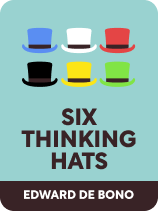

This article is an excerpt from the Shortform book guide to "Six Thinking Hats" by Edward de Bono. Shortform has the world's best summaries and analyses of books you should be reading.
Like this article? Sign up for a free trial here .
What is white hat thinking from the book Six Thinking Hats? What role does the white hat play?
In the classic psychology book Six Thinking Hats, Edward de Bono describes the white hat as the neutral hat. The role of the wearer is to simply gather and present the facts and figures without interpreting any of the data.
Continue below to learn how to wear the white hat and what the advantages are.
The White Hat
The white hat is the neutral hat. White hat thinking is the gathering of relevant factual information.
When you wear the white hat, you think about objective data. Emotions, judgments, and interpretations are quiet. Think of a white sheet of paper ready to be filled with information. This is the white hat.
White Hat Questions
While you’re wearing the white hat, consider these questions:
- What do we know?
- How important is this information in practical terms?
- How reliable is this information?
- What don’t we know that we need to find out?
- How will we find the missing information?
White Hat Data
White Hat data usually takes the form of facts and figures: sales figures, financial information, objective facts. Be as specific as possible:
- Avoid vague words like “trend” and “pattern.”
- Make sure to attach dates to figures wherever you can. For example, if you’re involved in a political campaign and are contributing polling data, make sure it’s labeled with the month and year it was collected. This will help you to avoid basing important decisions on old data.
White Hat data also includes the reported opinions and feelings of people not at the meeting, if they’re relevant. These can be things you’ve read (“Economics expert Dr. Julie Bloggs believes that interest rates will fall this year”) or opinions that were directly expressed to you (“My client Ms. Chan said that she’s thinking of finding another law firm with better customer service.”) You can include anecdotes under the white hat, but make sure they’re labeled clearly as such.
Avoid interpreting data while wearing this hat. Words like “because” and “so” belong to the yellow and black hats.
Accuracy
There are facts you’re completely sure of, facts you’re pretty sure of, and facts that you think might be correct. All of these are admissible under the white hat, as long as you label them correctly.
For simplicity’s sake, let’s classify white hat facts into two categories: Level 1 (certain, independently verified) and Level 2 (needs verification). Feel free to propose as many Level 2 facts as you like. But if you’re going to make a decision based on a Level 2 fact, make sure to verify it and take it to Level 1 first.
Probability
Truth is a philosophical question. It has to do with logic and mathematical proof. For example, if you go through your whole life only seeing orange carrots, you might believe the following statement to be true: “All carrots are orange.” But the moment you see a white or purple carrot, you have to acknowledge that this statement has been false all along.
If you’re thinking only in terms of black-and-white logic, you have to throw out the “All carrots are orange” statement completely. But Six Hats deals with practical thinking, not mathematical logic. If we waited to be absolutely sure in logical terms, we’d be waiting lifetimes, and Six Hats is about getting fast, practical results. In practical terms, it is useful to know that the vast majority of the carrots that you’ll encounter in your life (depending on the country you live in, of course) are orange.
At the other end of the spectrum, it’s also useful to know about rare exceptions (the purple carrot). For example, if you’re developing or prescribing medication, you need to know about any rare but serious side effects.
We can depict uncertainty as a continuum:
- Definitely true
- Usually true
- Often true
- Sometimes true
- True once in a while
- Very rarely true
- Impossible
It’s completely fine—even encouraged—to include uncertain information and rare exceptions. But remember to annotate any white hat contributions with this information.
How to Use the White Hat
- It’s good practice to put on the white hat toward the start of the session. You may also want to put the white hat on periodically to check for information around any new ideas or proposals that arise.
- Make sure that you explore the whole field of relevant data while wearing this hat. It’s easy to fall into the trap of only contributing information that supports your point of view. But this defeats the purpose of the white hat, which is to map out the cognitive terrain in an objective way.
Advice for Facilitators
- Guide the granularity of the data you’re targeting through questions. For example, you could say, “Let’s white-hat the economic environment for our product. What do we know?” Then you could narrow this to “Now find me X competitor’s annual report for last year.”
- Make sure you pose questions in the most neutral way possible. Avoid manipulating the discussion by seeking only facts that support your desired outcome.
Exercise: Try on the White Hat
Work with the white hat on a problem of your choice.
- Think of a decision you currently face, either at work or elsewhere in your life. What objective information will help you to make an informed choice? (Be as general or as specific as you like, but mark any general information that needs further investigation or confirmation.) Try to prevent any interpretations or emotions from sneaking in.
- What important information is missing? What have you noted that seems vague or out of date?
- Evaluate the information you’ve noted above. Is it genuinely balanced (might you have unconsciously selected it to favor one side or the other)? How might you go about finding some balancing information?

———End of Preview———
Like what you just read? Read the rest of the world's best book summary and analysis of Edward de Bono's "Six Thinking Hats" at Shortform .
Here's what you'll find in our full Six Thinking Hats summary :
- A handbook for training people to think more efficiently and productively
- An explanation of each of the six thinking hats created by Edward de Bono
- How to calm your inner critic and dramatically cut your decision-making time






